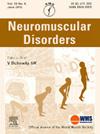Levels of exercise exposure among people living with neuromuscular disorders: lessons learned from real-world data
IF 2.7
4区 医学
Q2 CLINICAL NEUROLOGY
引用次数: 0
Abstract
There is growing evidence on safety and efficacy of exercise in neuromuscular diseases. We sought to establish the levels of exercise exposure for people living with NMD and its association with mobility levels and pain. A standardized questionnaire was used during clinical follow up consultations to categorise exposure to aerobic, strengthening and stretching exercise for 830 patients with 41 different NMD. The level of exercise exposure of people living with NMD in each type of exercise has been found to be limited and the proportion of patient being complying with WHO physical activity guidelines (8 %) was lower than previously reported. Stretching exercise was the most performed type of exercise (37 %), while resistance exercise was the least performed type of exercise (25 %) with aerobic exercise being performed by 33 %. Associations were found between exercise type and diagnosis, mobility status and pain all using chi square testing with significance level of less than 1 %. Patients with greater levels of mobility were more likely to participate in aerobic and resistance exercise and less likely to participate in stretching exercise. The presence of pain was associated with lack of participation in aerobic and resistance exercise but not stretching exercise. Levels of mobility and presence of pain have been identified as significant factors. It is critical to improve supported access and specific exercise guidelines for people living with NMD.
神经肌肉疾病患者的运动暴露水平:来自现实世界数据的经验教训
越来越多的证据表明运动治疗神经肌肉疾病的安全性和有效性。我们试图确定NMD患者的运动暴露水平及其与活动水平和疼痛的关系。在临床随访咨询期间,使用标准化问卷对830名患有41种不同NMD的患者进行有氧、强化和伸展运动的分类。已发现NMD患者在每种运动类型中的运动暴露水平是有限的,遵守世卫组织身体活动指南的患者比例(8%)低于先前报道。伸展运动是进行最多的运动类型(37%),而阻力运动是进行最少的运动类型(25%),有氧运动占33%。运动类型与诊断、活动状态和疼痛之间存在关联,均采用卡方检验,显著性水平小于1%。活动度较高的患者更有可能参加有氧运动和阻力运动,而不太可能参加伸展运动。疼痛的存在与缺乏参加有氧运动和阻力运动有关,但与伸展运动无关。活动水平和疼痛的存在已被确定为重要因素。至关重要的是,要改善NMD患者获得支持的途径和具体的运动指南。
本文章由计算机程序翻译,如有差异,请以英文原文为准。
求助全文
约1分钟内获得全文
求助全文
来源期刊

Neuromuscular Disorders
医学-临床神经学
CiteScore
4.60
自引率
3.60%
发文量
543
审稿时长
53 days
期刊介绍:
This international, multidisciplinary journal covers all aspects of neuromuscular disorders in childhood and adult life (including the muscular dystrophies, spinal muscular atrophies, hereditary neuropathies, congenital myopathies, myasthenias, myotonic syndromes, metabolic myopathies and inflammatory myopathies).
The Editors welcome original articles from all areas of the field:
• Clinical aspects, such as new clinical entities, case studies of interest, treatment, management and rehabilitation (including biomechanics, orthotic design and surgery).
• Basic scientific studies of relevance to the clinical syndromes, including advances in the fields of molecular biology and genetics.
• Studies of animal models relevant to the human diseases.
The journal is aimed at a wide range of clinicians, pathologists, associated paramedical professionals and clinical and basic scientists with an interest in the study of neuromuscular disorders.
 求助内容:
求助内容: 应助结果提醒方式:
应助结果提醒方式:


